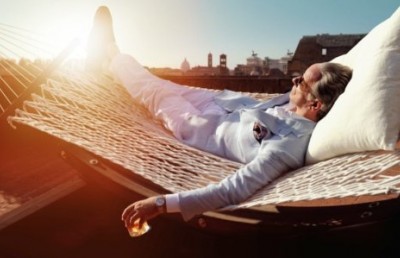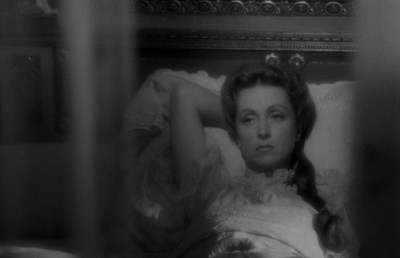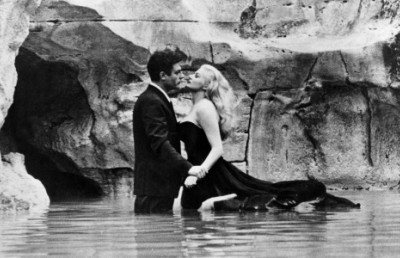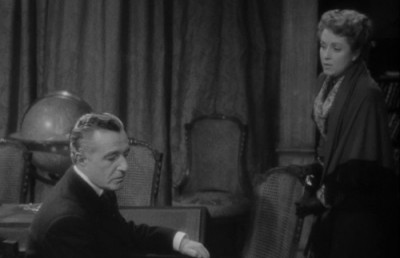Il Conformista: A Study in Contrast of Two Frames
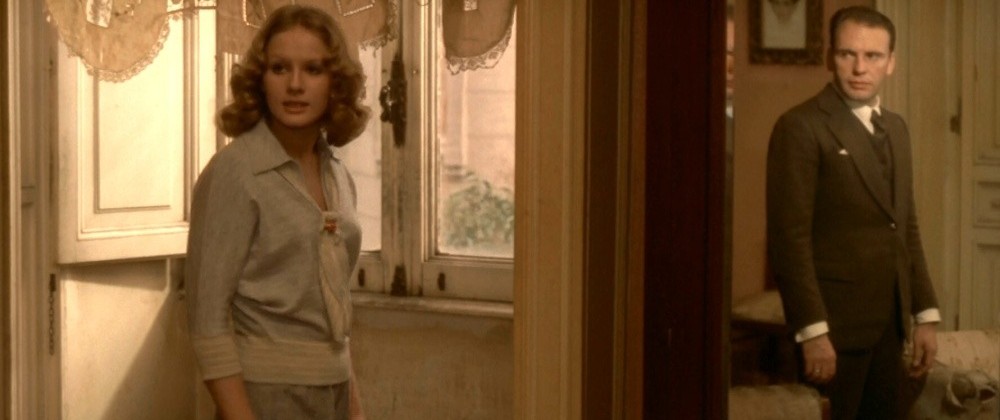
Bernardo Betolucci’s 1971 political art house thriller Il Conformista is one of the most revered pieces of stylistic excess. Countless young film directors, cinematographers and cinephiles rank the film as a warehouse of vaunted shots, scenes and moments. Lauded by many as one of the most visually splendorous color films ever made, Il Conformista is a beautiful looking film with beautiful looking people: Jean-Louis Trintignant, Dominique Sanda and Stefania Sandrelli. Il Conformista was famously photographed by his many time collaborator, Vittorio Storaro, a learned cinematographer well versed in the history of painting, color theory and cinema history. Storaro left little to chance and used his tools to literally ‘paint with light’. His approach to this film was very articulate and he, along with Bertolucci, came up with a central guiding force to the film’s visual style, which included all aspects of the mise en scène, which includes Settings and sets, Props, Actors (performance & blocking), Costumes & make-up, Lighting and Composition/framing. Storaro is quoted as saying that he drew inspiration for the lighting from the Caravaggio painting “La Vocazione di San Matteo” and expanded its use of Northern Lighting to encompass the moral, political and spiritual journey of Marcello Clerici (Jean Louis Trintignant), a petty bourgeois during the early Fascist days of Italy who aspires to lead a ‘normal’ life by serving as best as possible the leading Fascist light of Italy. Storaro says of the painting that the separation between light and darkness, is a reflection of the divine and the human, and he used this as a guide to the symbolism he and Bertolucci wanted to invoke across the film, with light reflecting Clerici’s consciousness and darkness reflecting his unconscious or the repressed (i.e. homosexuality) side of his identity. The dark or ‘scuro’ represents the ‘character’s ‘subconscious’’ and the light or ‘chiaro’ represents his ‘consciousness’, perhaps thinking it could work as a grand metaphor of all of Italy under Fascism. The use of the Northern light in the painting can be seen as a direct influence in the frame below, where we see Clerici’s blind Fascist friend Italo (José Quaglio) standing alone in the basement. The manner and direction of the source light, the sharp contrast and the graphic linear lines are lifted from the Caravaggio painting.
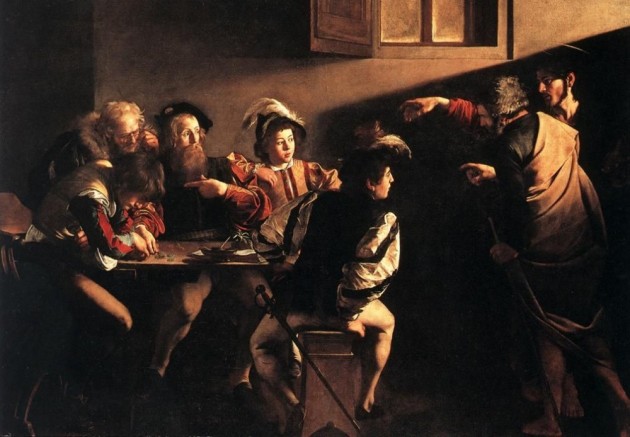
“La Vocazione di San Matteo”
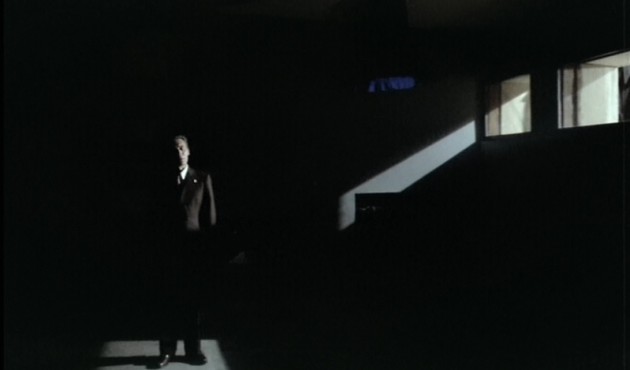
Another other visual and philosophical touchstone for Bertolucci and the sophisticated Storaro is Plato’s “Allegory of the Cave” which is cited in the film as Clerici ‘s thesis subject when he studied under professor Quadri (Enzo Tarascio). When Clerici meets his old professor in Paris they reminisce about his work and they act out Plato’s allegory about reality and appearances; the film in turn is filled with allusions, many playful to the point of parody, to this philosophical statement about how the reality we see in front of us is often an illusion or false impression. We can see it in the sky patterned wall paper in Clerici’s son’s room, the painting of a beach resort which dissolves into the actual location, and the fantastical changing views outside the moving train window in the ride to Paris, which feels like an old moving diorama. In an interview in Film Quarterly Storaro has said that his decision to bath Paris in a cobalt blue light was largely intuitive, and only rationalized later as a symbolic indicator of Paris as a Nation free from dictatorship. This ‘freedom’ was represented by “letting the light go into the shadows” in the Paris scenes, and bathing Paris in a blue light (p. 20). This stylized depiction of Paris is announced brilliantly during the train ride, by having the lighting outside the moving train window switch instantly from a golden sunset to a striking night blue once they arrive in Paris.
‘Paris in Blue’
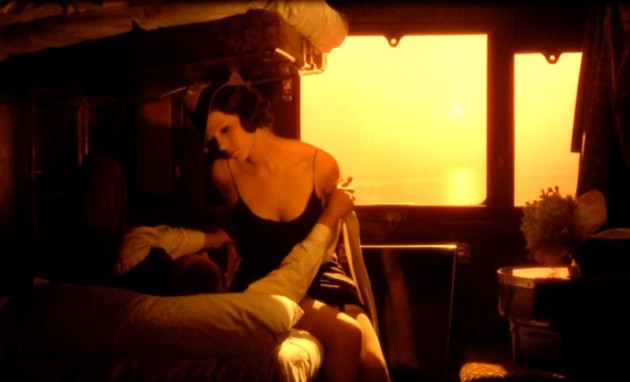
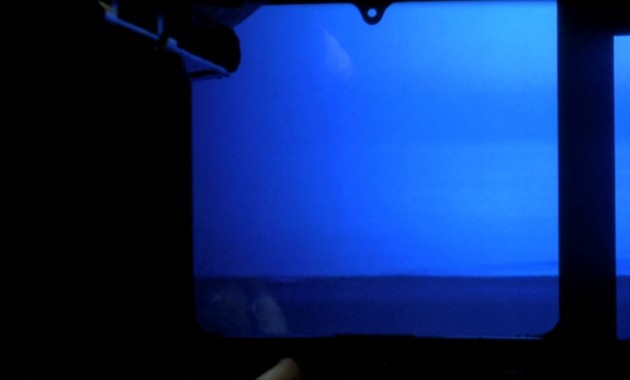
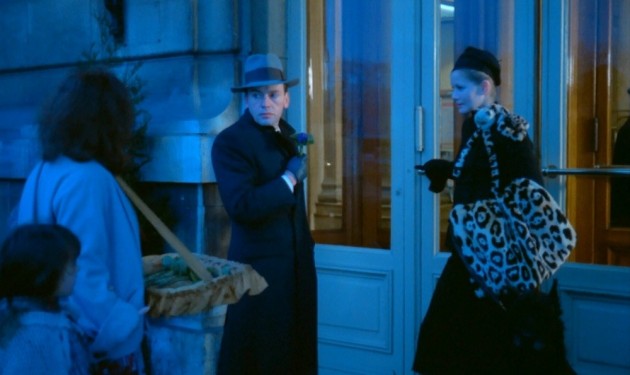
The film is a non-linear stream of consciousness flashback structure narrative that begins in Paris 1938 with Fascist agent Marcello Clerici (Jean-Louis Trintignant) meeting and being driven by his strong-arm chauffeur Manganiello, (Gaston Moschin) and ends at the fall of Mussolini toward the end of the war, 1943. The film weaves seamlessly between events of Marcello’s life, going as far back as a young boy in 1917, where we witness a traumatic homosexual encounter with an automobile chauffeur named Lino, a character who Clerici thought he had murdered but who returns in the film’s final act in 1943.
Although the film is giddy with subtle stylistic variance, moving effortlessly between 1930s/1940s gangster & film noir expressionism, art deco playfulness, Renaissance beauty, and Ophulsian & Sternbergian decadence, there is also an overall pattern that can be discerned. The film’s visual style for the scenes prior to Clerici joining the Fascist party is exuberant and playful; the visual style for the film’s middle or Fascist years remains stylized but with portentous architectural spaces dominating the mise en scène; while the scenes in the final time frame, after the dethronement of Mussolini, when Clerici’s idealized notion of Fascist ‘normalcy’ is shattered, are the most sombre and downbeat. This pattern is noticeable across many scenes in the film, but is encapsulated pointedly in two shots taken from opposite ends of the film but in the exact same physical space: a view of both the living room and adjoining hallway of Giulia’s (Stefania Sandrelli) parental home.
The first of the two shots we will closely examine takes place sometime before 1938, when Marcello visits his fiancée Giulia (Stefania Sandrelli) and has a frank pre-marriage discussion over dinner with Giulia’s mother (Yvonne Sanson). The second image takes place after they have been married, in 1943, with Marcello, Giulia, and their young son living with Giulia’s parents. The first image sees Marcello’s at his happiest moment, courting both his fiancée Giulia and the Fascist Party, which he enlists in as a covert political officer in charge of eliminating political dissidents. As he becomes further involved in the Fascist inner circle he is given orders to visit a certain former intellectual Marxist living in Paris, Professor Quadri (Enzo Tarascio), and to eliminate him. Clerici is chosen for this task because of his history with the professor: Quadri was his former University mentor who supervised his graduate thesis on Plato’s famous allegory of the cave (the parable itself serving as both a visual and philosophical analogy for the film).
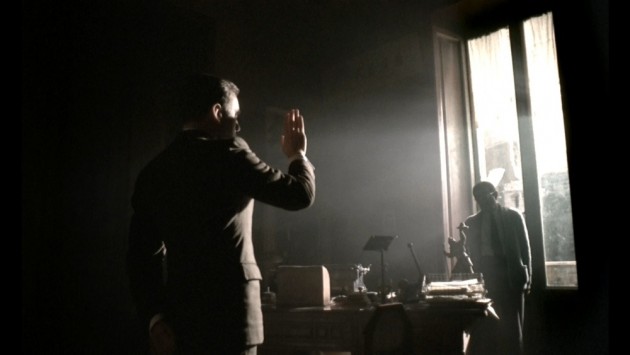
Clerici and Quadri play out the allegory of the cave
The events surrounding the lead up to the moment of this first image includes visits with his mother at her dilapidated mansion and with his mentally ill father at a sanatorium (image above); a visit with his blind Fascist friend Italo at a radio station, and his pre-marriage confessions at a church. The visit of Italo at the 1930s radio station is playful in the way the framing sets up a wide screen ratio frame within a frame, with Clerici, back to the audience (as he will be once again for the enigmatic final shot of the film), being a spectator to the popular all-girl singing group. The visit of his father at the mental institute is an example of Storaro and Bertolucci’s stylized, theatrical mise en scène, with the space dominated by the ‘sickly’ institutional color white and the mannered ‘architectural’ positioning of the characters. The shot contains substantial depth of field, compared to other shots where the frame is flattened by a wall. The wall in this shot is far back but the lack of separation between the wall and the white sky projects a foreboding sense of enclosure, a symbol of Italy’s dim future in light of Fascism.
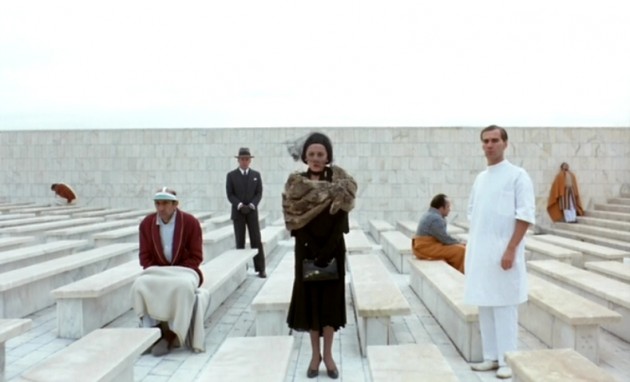
Theatrical mise en scene
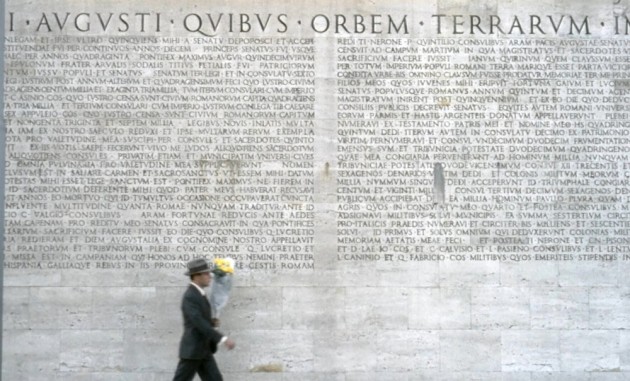
Space flattened
The impressive wall with Latin inscription in the scene where Clerici, flowers in hand, is on his way to visit his fiancée captures a similar sense of no future. These two images can be compared in their rendering of flatness with a shot from 1943 where Clerici recites the Hail Mary as he puts his son to bed. In this shot the sky patterned wall paper that flattens the space renders a false sense of joy and happiness, and stands in stark contrast to the archly noir image of Giulia sitting alone in the darkened salon moments after the radio has announced the fall of Mussolini.
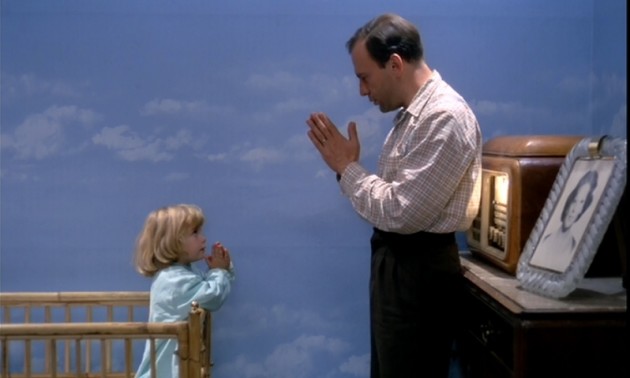
Space flattened
The shot of the sky patterned wall paper strangely recalls the earliest chronological event in the film, Clerici’s childhood memory from 1917 of his troubling encounter with Lino the chauffeur. The opening of this scene takes place in the lush green gardens surrounding the villa where Lino will lead young Clerici into for a near sexual encounter. Unlike the majority of the film which features non-naturalistic light, this part of the scene takes place in an airy sunny outside setting. The panning and zooming camera movements that follow Clerici and Lino as they chase each other around the grounds, like the wall paper, projects a false sense of joy and light heartedness. As the only scene that takes place prior to Fascism (which began in 1922), this may explain the lightness of touch and high key visual style.
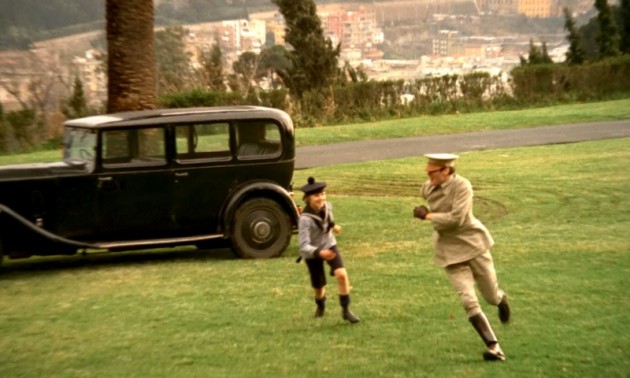
False exuberance
A Study in Contrast of Two Frames:
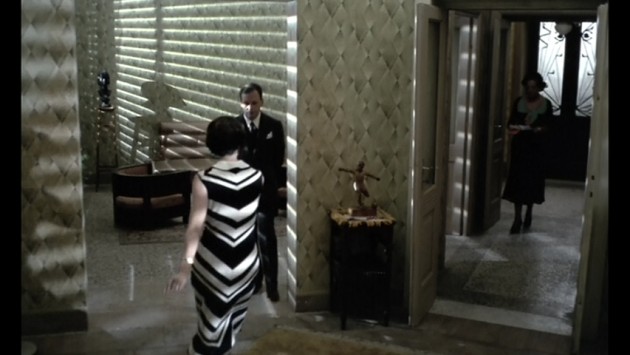
1930s
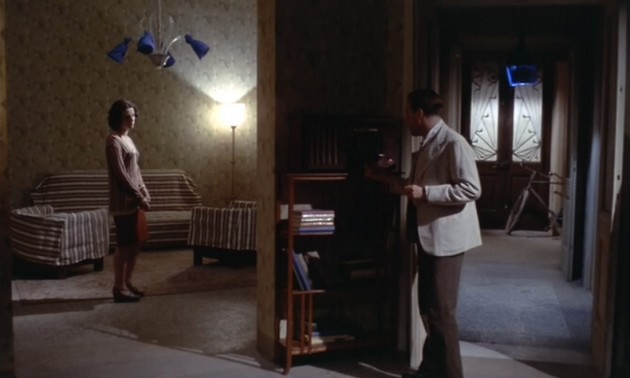
1940s
The two shots I will now closely compare represent the time frames of, roughly, the mid-1930s and 1943. They represent an almost identical camera position in the home of Clerici’s future in-laws. A study of the noticeable differences in the two images –henceforth referred to as the earlier and later shots– reveals some intriguing possibilities explored by Storaro and Bertolucci to represent Clerici’s –and by extension Fascist Italy’s– changed state of anima. The earlier 1930s shot evokes a mood of playfulness and joy which is dramatically flipped in the later 1940s shot. Though this is clearly the same space in the house there are significant changes in all aspects of mise en scène, which reflect character and narrative changes. The lighting is one of the more important indicators. The lighting is low key in both shots but is more stylized in the earlier one, with the 1930s, 1940s patterned film noir venetian blinds playfully matching Giulia’s ‘black & white’ dress pattern. The lighting in the later shot is much more somber, reflecting the changed attitude in the household after the fall of Mussolini. Both shots are marked by a hard light, with a fairly high contrast created by the uniform darkness on the bottom and brighter lighting in the earlier shot (reflecting a more joyous point in the life of the characters). Except for the dark patch in the middle wall, the lighting in the later frame is uniform, with softer shadows than the earlier shot, pictured on top. The art direction is more conservative in the later shot, stripped of the playful inter-textual referencing to American gangster and film noir of the earlier shot. While both shots are long shots, the earlier shot is framed from a slightly higher camera angle position. There are significant changes to the set and props. The wall opening to the living room is larger in the later shot. The middle room divider is changed, with the wall in the earlier shot becoming an alcove area in the later shot (perhaps suggesting the hidden aspects of their past?). There are different light fixtures across the two shots. In the earlier shot we see a table in the living room but no couch. In the later shot we see a couch but no table. The maid (or mother?) seen in the hallway in the earlier shot is absent in the later shot, replaced by a bicycle in the bottom frame. There are significant changes in the character blocking: in the earlier ‘happier’ time the two characters are on the same side of the wall split, facing each other and dancing, but they are separated in the later shot. This also reflects the change in attitude and tone: more somber, more conservative, with the characters now less intimate, troubled by recent political events. The costume also reflects this change: flashy and dapper in the 1930s, drab and conservative in 1943.
And one of the oddest and potentially most significant changes: the corridor in the earlier time frame veers to the right at a far greater angle than in the later shot. Why did Bertolucci go to the trouble of making structural changes to the space? Could this symbolize all of Italy being more to the ‘political right’ in the 1930s, as opposed to the turn to the political left/center during the 1940s!!!! These two images mirror each other but hold significant changes in tone, mood and mise en scène. This playful but meaningful use of a mirroring device, while not uncommon, is used ingenuously by Bertolucci here and elsewhere. Even the opening and closing shots of the film announce themselves this way. The film opens on a medium long shot of Clerici lying on his hotel bed facing the camera, bathed in a sickly red-orange light flashing intermittently from an neon light outside the hotel window. The film concludes with Clerici framed with his back to the wall leaning against a prison-like gate. The lighting here too is the same red as in the opening, only this time caused by a small off-frame bonfire that street dwellers use for heat. As if attempting to look back at himself, he turns to look directly at the camera. The effect is not only to ‘mirror’ the opening shot, but to make one final reference to Plato’s parable of the Cave: reality as something we can only secure in our hands for a brief moment, before it slips away into uncertainty, illusion, and doubt.
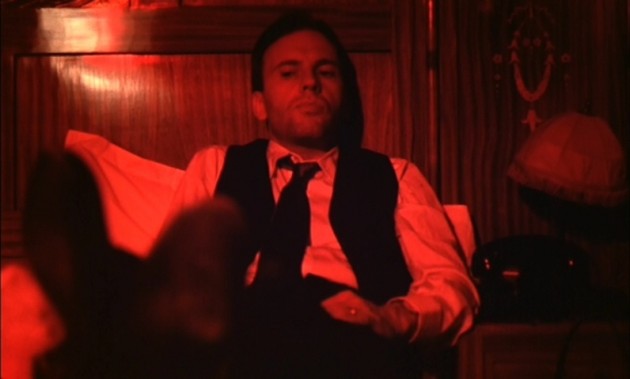
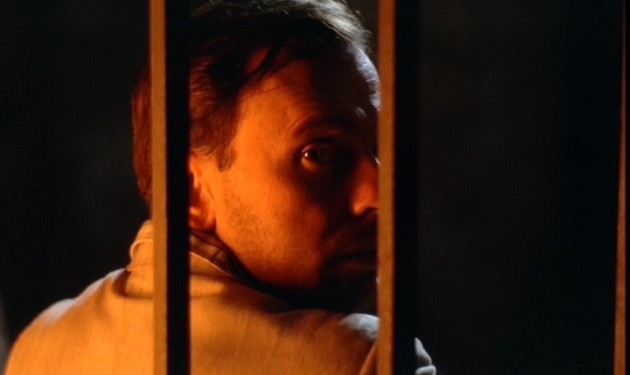
Bibliography
David Schafer, Larry Salvato, Vittorio Storaro, “Writing with Light: An Interview with Vittorio Storaro.” Film Quarterly Vol. 35, No. 3, Spring, 1982, pp. 15-25



